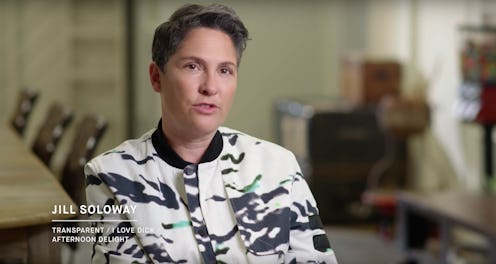Entertainment
This Powerful New Doc Explores Hollywood's Serious Lack Of Female Directors

Hollywood has a women problem. Between the unfolding horrors coming out daily after the #MeToo floodgates opened and the unfair beauty and age standards imposed on women in front of and behind the camera, things for ladies in the film and TV industries aren't particularly great. But one problem — the ridiculously low number of women directors — is at least being addressed head-on, in the new documentary Half The Picture. The doc, out June 8 in New York, June 22 in Los Angeles, and on VOD July 24, features prominent women in the entertainment world speaking out about how they've managed to get where they are and analyzing why so few female filmmakers exist. In other words, it's an essential movie that addresses one of Hollywood's biggest blind spots.
In 2016, The Celluloid Ceiling reported the dire statistic that only 7 percent of directors working on the previous year's top 250 domestic grossing films were women. They fared slightly better in the independent world, but still fell far below the 51 percent female general population, and the even higher number of female moviegoers at 52 percent. So what gives? Why aren't more women ending up in a position of creative control? That's the question Half The Picture aims to answer.
In the exclusive clip below, Jill Soloway — creator, director, and writer of Transparent and writer for Six Feet Under (along with numerous other shows) — can be seen talking about her difficult move from writer to director. As a writer, Soloway had issues with lack of control or things not being done "right" on her projects, but not the power to do anything about it. Luckily, she eventually realized she wanted that power, and that the issues she had on set could be resolved by her taking creative control herself, i.e. becoming a director.
It's telling that even for someone as familiar with the industry and sure in her own skills as Soloway, the decision to step into the director's chair can be complicated. A woman could have the verve to push back in the writers' room and advocate for stories not being told to make it to screen, but that doesn't mean she sees the path to directing as clear. And the active thwarting of women's directorial ambitions through sexism and gatekeeping leads to women themselves internalizing those attitudes and often not even thinking of themselves as "director material" to begin with.
As seen in the trailer for Half the Picture, even women who strive for the director's seat sometimes blame themselves for failing, believing they didn't work hard enough or that they still have to "be better" somehow. It's not as if there were an imbalance of women entering the field to begin with; an average of 50 percent of film school graduates are women, LA Weekly reports. But the ludicrously low statistics of female filmmakers who then move up in the industry point to a larger, sadder force at work.
One woman in the Half the Picture trailer sums the world for women filmmakers up like this: "it can create an environment in which we feel like our very femaleness is some kind of disability. It's not." Internalized sexism takes all kinds of forms, and far too often, women unfairly blame themselves for not getting what they want, despite the real barriers in their way and other forces at work.
Half The Picture's own director, Amy Adrion, spoke with Film Inquiry about trying to break that cycle. Her doc's narrow focus on just female directors is intentional, she said, explaining, "We don’t get into the sexism actresses face, or challenges encountered by female producers, writers or executives...study after study has shown that when women direct, that has a significant impact on how the characters onscreen are portrayed and how many women work in key below-the-line jobs...Basically, the director is a gateway job and if you can change the numbers there, there will be ripple effects throughout the industry."
As the saying goes, things always look darkest just before dawn. Even after the ACLU's landmark 2016 study revealed a clear industry-wide systematic bias against women, the numbers for 2017 show a mere 1 percent increase for women working on the top 250 highest-grossing films. Progress will be slow, but at least it's moving forward, and films like Half The Picture will help point out the issues women face in the meantime.